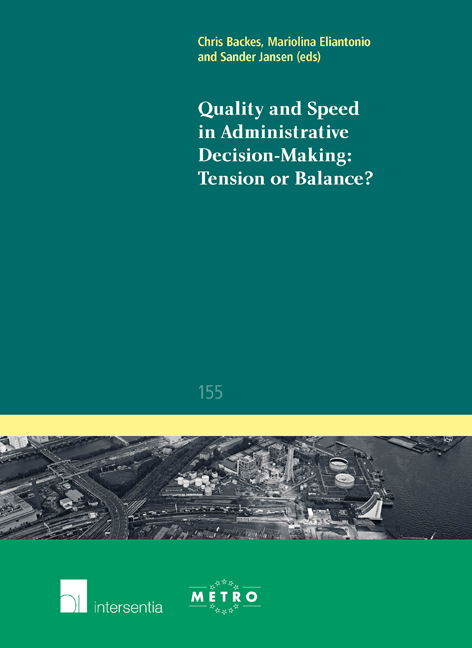Book contents
- Frontmatter
- Contents
- List of Authors
- List of Abbreviations
- Introduction
- Quality and Speed in Administrative Decision-Making: A German Case Study
- The Quest for Quality and Speed in Italian Administrative Law Or the Tale of some Elusive Targets
- Quality and Speed in Administrative Decision-Making: A French Case Study
- Planning for Major Infrastructure in England: Front-Loading Participation in the Interests of Efficiency
- Quality and speed in Judicial Procedures and Administrative Decision-Making: Environmental Permits in Sweden
- Faster and Better!? Decision-Making in the Netherlands
- Conclusions
- Ius Commune Europaeum
Quality and speed in Judicial Procedures and Administrative Decision-Making: Environmental Permits in Sweden
Published online by Cambridge University Press: 12 December 2017
- Frontmatter
- Contents
- List of Authors
- List of Abbreviations
- Introduction
- Quality and Speed in Administrative Decision-Making: A German Case Study
- The Quest for Quality and Speed in Italian Administrative Law Or the Tale of some Elusive Targets
- Quality and Speed in Administrative Decision-Making: A French Case Study
- Planning for Major Infrastructure in England: Front-Loading Participation in the Interests of Efficiency
- Quality and speed in Judicial Procedures and Administrative Decision-Making: Environmental Permits in Sweden
- Faster and Better!? Decision-Making in the Netherlands
- Conclusions
- Ius Commune Europaeum
Summary
Introduction
Environmental legislation and its implementation through administrative decisionmaking and judicial procedures has had a key role in addressing many environmental problems in Sweden. The reduction of industrial pollution particularly from point sources (that is, identifiable pollution sources) is to a great extent attributed to the enforcement of the Environmental Protection Act (Miljöskyddslag) 1969. This Act introduced a general permit system in which the issue of permits was conditional on the applicant using the best available technology. The result is that industry has managed to cut 99 percent of emissions since the 1960s due to new and rebuilt plants using the latest techniques.
The Environmental Protection Act was followed by a number of new laws in the 1970s that aimed at further protection for human health and the environment. This meant a patchwork development of environmental legislation as several overlapping duties and procedures were laid out, and this affected both the quality and speed of administrative decision-making in the field. In the late 1980s the government appointed a state commission to analyse the possibility of merging some of this environmental legislation to make regulation less complicated, to centralize its organization and to have a more efficient and seamless permit system.
In 1999 the Environmental Code (Miljöbalk) was enacted. It replaced 16 environmental laws and created a more comprehensive regulatory system. The overarching objective of the Code is to promote sustainable development that will ensure a healthy and sound environment for current and future generations. In principle the Code applies to all activities within Swedish territory that may harm the environment or human health. All such activities must be carried out in compliance with general rules of conduct (chapter 2 of the Code) but might also need to be carried out in accordance with special rules of conduct depending on the type of activity (chapter 9-15 of the Code). The general rules of conduct require precautionary measures to be taken, such choosing a location which is likely to cause as little harm as possible to the environment and public health, or using as little energy and raw materials as possible.
- Type
- Chapter
- Information
- Publisher: IntersentiaPrint publication year: 2016

